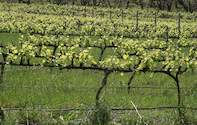Grapevine training restricts the development of the vine to a primary shoot (trunk) and cordon arms (part of the vine’s woody framework) as well as the excessive development of branch shoots.

The purpose of grapevine training is to ensure the vines’ cordon arms are equally long and thick and evenly positioned on the cordon wire. The grape bunches develop on these cordon arms later on.
Grapevine training thus determines the vine shape. It is important that the vine, which is a runner-plant, has a straight trunk. Straight trunks ensure that the cordons are of equal length. It also means that the grape bunches are more even and a better quality if the bearers are well spaced and thus equally strong.
Where bunches do not equally develop on the cordon arms the colour may be impacted and the grapes damaged. Good quality grapes may not be produced.
Grapevine Training on a Trellis System
Young vines must regularly be attached to a reed, piece of wood or wire rod by means of ropes or plastic strips by trained workers. The purpose of this is to prepare the young plant for further growth on the trellis system to which it will be attached later on. The purpose of head suckering is to eliminate unwanted shoots, especially water shoots and to refer the growth of the vine to the cordon arms.
This can cause the vine to grow more quickly and not waste its growth force in forming unwanted shoots. After planting time (or after the first year’s growth), the vine is cut back to only two buds. After that, the most powerful shoot is used to develop as the main trunk. Topping is done on the second shoot and it is kept as an additional shoot while the rest is suckered away.
Topping is the removal of 15-25 cm from a shoot. The main trunk should be kept as straight as possible by pulling it upright regularly. Crooked trunks complicate tractor and harvest machine movement in the rows and also cause the trunk’s cordons not to be the same length on either side.
As soon as the primary shoot grew about 30 cm above the cordon wire, the shoot is topped at the first internode, just above the cordon wire. This stop of upward growth will cause branch shoots to evolve from the upper part of the primary shoot. Two branch shoots, one on each side, are left to develop as the future cordon. An additional shoot is also left if one of these gets damaged.
Grapevine Training Tips
Grapevine training is a very important phase in the vineyard lifetime and is largely determined by the vigour in ‘Year One’. The vigour shall determine when grapevine training should begin. However, decide early on the method of grapevine training and keep to it. Vine form, as well as the number of bearers is now determined to influence production later.
During this phase all dead vines must be replaced and the scion wood (wood taken from a cultivar for grafting onto a rootstock) that has broken off at the graft union should also be replaced.
Pay attention to the management of the additional shoots – one for the trunk and one for the cordon. Topping should be done so that they do not compete with the primary shoots. If the primary shoot gets damaged it should be cut down to the additional shoot. During this phase new bearers can be formed by using a water shoot.
Pay special attention to shoots that are wrongly tied and pinched by a string around the main trunk. While the vines are young, wide branches need to be addressed. Cordon shoots can even be interwoven to ensure a narrow branch. Preferably there should be no bearers.
No bearers are developed at the bottom of the branch - bearers are only developed at the bottom of the cordon if a bare top is encountered.
The golden rule of grapevine training is: if you are in doubt, cut back. Always use the pencil thickness rule to determine where to cut back. If there are no shoots on the cordon, cut back to a strong branch shoot and fold this onto the cordon. Do not hesitate to cut back to only two buds or if you are not satisfied with the trunk shape.
Bush Vine Training
In dry areas, where no irrigation is provided to the vineyard, vines are usually planted further away from each other. With bush vine training a short trunk with 6-8 bearers whose inner section is open should be the aim. A soccer ball should be able to fit inside the opening.
Thus, it is necessary to try to remove all shoots that grow inward during canopy management and to remove shoots that grow downwards with head suckering. Shoots are deliberately cut to an outside bud so that no branch shoots develop on the inside of the plant. During bush vine training, crop management should be strictly enforced by removing bunches.
Grapevine Training for Mechanical Pruning
Where a vineyard is planted to be mechanically pruned in future, good growth is a prerequisite for the vine to grow higher than in normal trellis systems.
It is especially important if the cordon is to be fully developed in year one. It is mainly determined by soil potential as well as cultivar and rootstock combination.
Traditional canopy strands are not used in mechanical pruning systems. There are different trellis systems available. One is to let the cordon develop on one side only and to allow the vine to grow beyond the adjacent vine.
By Vinpro